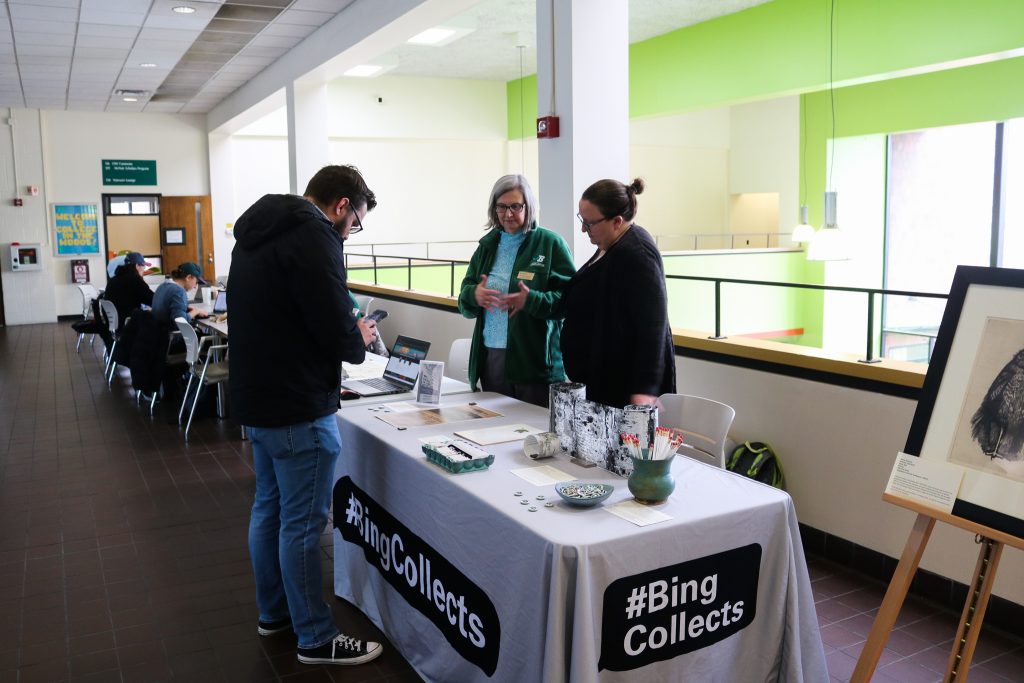The Binghamton University Special Collections, Art Museum and Nature Preserve collaborated on a pop-up exhibition focusing on planet Earth this past Wednesday, March 20 in the College-in-the-Woods Dining Hall.
The “#BingCollects: Planet Earth” exhibition was organized by Blythe Roveland-Brenton, the director of Special Collections, Claire Kovacs, the curator of collections and exhibitions at the BU Art Museum and Dylan Horvath, the steward of natural areas at BU. Each person brought artifacts and artworks from their departments that connected to the overarching theme of planet Earth.
In relation to the history of BU and the local area, Roveland-Brenton brought a photograph and a copy of the front page of the Colonial News, which was developed into Pipe Dream in the late 1960s. The photograph is of graffiti on a construction sign for College-in-the-Woods.
“The photographs are related to the protests against the construction of College-in-the-Woods, as it was originally conceived because of the impact that it would have on the environment and the tree stands that were here,” Roveland-Brenton said.
Roveland-Brenton brought a guide to Broome County trees, written and illustrated by the naturalist club in 1970. It is a guide book to Broome County parks, which identifies all the local trees. From the rest of the Special Collections, Roveland-Brenton brought an artist’s book which reflects that of a birch tree bark.
“I brought an artist’s book that mimics the look of a paper birch tree bark, that addresses the effects of global warming on the stands of trees in boreal forest and how those boreal environments are migrating north,” Roveland-Brenton said. “We spend time together identifying items in our respective collections that we are thinking about using, and how those would juxtaposed with each other.”
Kovacs brought an etching by Aubrey Schwartz, a BU faculty member in printmaking from 1969 to 1994. According to Kovac, Schwartz was known for his prints and drawings of animals. His print of a hawk standing on one foot spins off of the theme of planet Earth, as it is one of the hawks in the local ecosystem. Though the species of the hawk is unclear, a few hawks that are in the Nature Preserve include the red-tailed hawk, the broadway hawk and the cooper’s hawk.
The Nature Preserve incorporated a natural collection of the local ecosystem. Horvath explained that he brought specimens of animals, or signs of animals from the nature preserve.
“The idea of this is that the Nature Preserve is a collection that is outdoors,” Horvath said. “You can’t quite see all the things that are out there all at once, [since] it is a natural collection. The Nature Preserve is a natural laboratory for people. Students do class projects and research out there — it is a natural laboratory for the people.”
Visitors could pick up specimens from the touch table, which featured a bat, a porcupine quill, a possum, a raccoon, a mink, bird nests and a yellow jacket nest.
Kovacs explained how the pieces presented at the “#BingCollects: Planet Earth” exhibition drew together elements from BU’s various collections and the natural area.
“We are really thinking about ecosystems,” Kovacs said. “Special Collections is thinking about the space we are in right now, which is College-in-the-Woods, and the history of [College-in-the-Woods]. For me, bringing in a work from our collection that shows a hawk ties really nicely into the Nature Preserve, and the species of flora and fauna that are just over [there], where you can walk those paths. These are these connections between our collections that have just been waiting for us to discover.”



